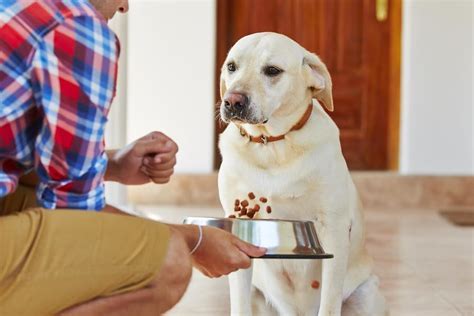Introduction

Fear is a common issue among dogs, affecting an estimated 20-40% of the population. While there are many factors that can contribute to dog fear, nutrition is often overlooked as a potential culprit. In this comprehensive guide, we will explore the link between dog fear and nutrition, and provide evidence-based strategies for addressing this issue.
1. The Role of Nutrition in Dog Fear
1.1. Nutrient Deficiencies
Certain nutrient deficiencies, such as magnesium, B vitamins, and antioxidants, have been linked to increased anxiety and fear in dogs. These nutrients are essential for maintaining a healthy nervous system and regulating stress hormones.
1.2. Food Additives
Some food additives, such as artificial flavors and preservatives, can trigger anxiety and fear in some dogs. These additives may alter the dog’s brain chemistry and lead to behavioral problems.
1.3. Food Allergies
Food allergies can also contribute to dog fear, as they can cause inflammation and gastrointestinal distress. This discomfort can make dogs more anxious and fearful.
2. Nutrition Strategies for Reducing Dog Fear
2.1. Nutrient-Rich Diet
Feeding a diet rich in essential nutrients, including magnesium, B vitamins, and antioxidants, can help support a healthy nervous system and reduce anxiety and fear.
Table 1: Nutrient-Rich Diet for Dogs
| Nutrient | Sources |
|---|---|
| Magnesium | Leafy green vegetables, almonds, bananas |
| B vitamins | Eggs, meat, poultry |
| Antioxidants | Fresh fruits and vegetables, leafy green vegetables, whole grains |
2.2. Avoid Food Additives
Choose dog foods that are free from artificial flavors and preservatives. Opt for brands that use natural ingredients and whole foods.
2.3. Eliminate Allergens
If you suspect your dog has a food allergy, work with your veterinarian to determine which foods are causing the reaction. Once identified, eliminate those allergens from your dog’s diet.
2.4. Supplementing with Herbs
Certain herbs, such as chamomile and valerian root, have calming effects and may help reduce dog fear. However, consult with your veterinarian before giving your dog any supplements.
3. Additional Strategies for Coping with Dog Fear
In addition to nutritional interventions, there are several other strategies that can help cope with dog fear:
3.1. Behavior Modification
Desensitization and counterconditioning are effective behavior modification techniques that can help dogs overcome their fears. These methods involve gradually exposing your dog to the feared object or situation in a positive way.
3.2. Medication
In severe cases, medication may be necessary to manage dog fear. Your veterinarian can prescribe medication that can help reduce anxiety and fear, such as antidepressants or anti-anxiety medications.
3.3. Environmental Management
Creating a safe and comfortable environment for your dog can help reduce their anxiety and fear. Provide them with a quiet place to retreat to, and minimize stress triggers in their surroundings.
3.4. Socialization
Socializing your dog early and often can help them become more comfortable in social situations and reduce their fear of strangers and other animals.
4. Pain Points, Motivations, and Market Insights
Pain Points:
- Dog owners are frustrated by their dog’s fear, which can lead to behavioral problems and a reduced quality of life.
- Owners may feel overwhelmed and unsure of how to help their fearful dogs.
- Fear can lead to costly veterinary bills for treatment and management.
Motivations:
- Dog owners want their dogs to be happy and comfortable, and fear is a major barrier to achieving this.
- Owners are motivated to find effective solutions to their dog’s fear.
- The growing pet industry provides a demand for innovative products and services that address dog fear.
Market Insights:
- The global pet care market is projected to reach $220 billion by 2025.
- The demand for products and services that address pet anxiety is growing rapidly.
- There is a need for more research and development on the link between dog fear and nutrition.
5. Effective Strategies and Tips
Effective Strategies:
- Implement a nutrient-rich diet, avoiding food additives and allergens.
- Combine nutritional interventions with behavior modification techniques.
- Create a safe and comfortable environment for your dog.
- Socialize your dog early and often.
- Consult with your veterinarian to determine if medication is necessary.
Tips and Tricks:
- Keep a food diary to track your dog’s diet and identify potential triggers.
- Look for dog food brands that are certified by the American Kennel Club (AKC) or the Pet Food Institute (PFI).
- Use interactive feeding toys to make mealtimes more engaging and less stressful.
- Provide your dog with plenty of exercise, as this can help reduce anxiety and improve mood.
- Seek professional help from a veterinarian or certified dog trainer if your dog’s fear is severe or persistent.
6. Conclusion
Dog fear is a complex issue that can be influenced by a variety of factors, including nutrition. By understanding the link between dog fear and nutrition, and implementing evidence-based strategies, dog owners can help reduce their pet’s anxiety and improve their overall well-being. With a combination of nutrient-rich diets, behavior modification techniques, and other coping mechanisms, dog owners can provide a safe and supportive environment for their fearful companions.





















